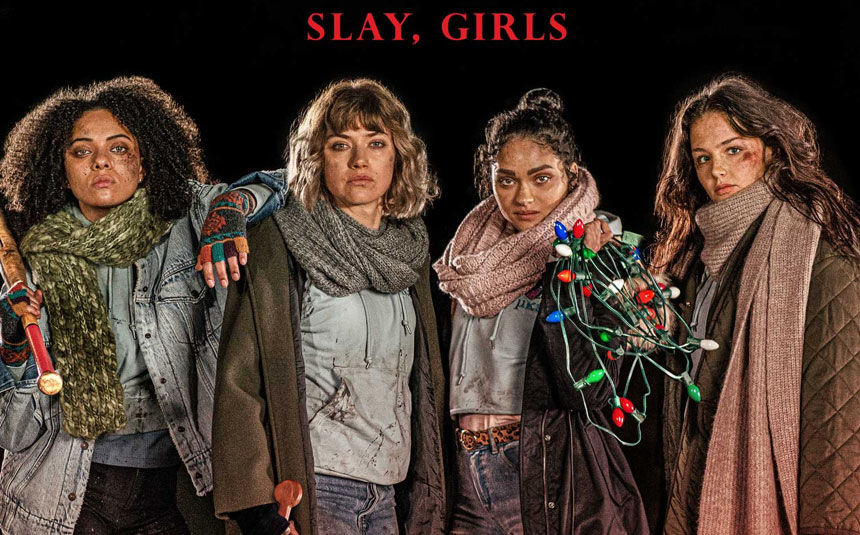Create a free profile to get unlimited access to exclusive videos, sweepstakes, and more!
Look of the Week: Black Christmas leans into Final Girl style

Welcome back to Look of the Week, celebrating the best in TV and film sartorial excellence, past and present across sci-fi, horror, fantasy, and other genre classics!
Horror reboots, revivals, and remakes are an expected byproduct of the genre. Monsters, villains, and Scream Queens are routinely resurrected, drawing on the trends and social issues of the era. Scary movies are often allegorical, using subtext to draw on political and societal fears. The third incarnation of Black Christmas opts out of subtle messaging, using the slasher narrative to examine college campus rape culture — and rather than one Final Girl, there is now a sorority full of them.
Clothes help us identify who will likely survive a scary movie bloodbath as a result of some well-established sartorial rules. A Final Girl typically dresses in a more understated manner, wearing staple pieces that eschew fads. From Laurie Strode (Jamie Lee Curtis) to Sidney Prescott (Neve Campbell), the look is heavy on jeans, tees, sweaters, and button-downs.
In recent years, there have been subversions to the trope that Carol J. Clover first defined in the seminal text Men, Women, and Chain Saws. Jamie Lee Curtis reprised the role of Laurie (aka the OG Final Girl) in last year’s direct sequel to the original Halloween, which gave the actress a chance to address the long-term effects and PTSD of an event this traumatic, which not only informed this character but two other generations of Strode women. It is also worth noting that the original Black Christmas paved the way for John Carpenter's genre-redefining masterpiece; Jess (Olivia Hussey) walked so Laurie could run.
In 2019, the Final Girl has taken several forms, including the ‘80s slasher-focused season of American Horror Story that played with the archetype but stuck to the signature clothing style. Ready or Not revealed a non-jeans wearing version who weaponized the wedding dress she spent the whole movie wearing. Black Christmas also transforms a garment into a form of defense, a frock that is also symbolic of a deeper trauma.
Clothing is something that comes up time and time again after a sexual assault. “What were you wearing?” is a loaded question that inexplicably shifts the responsibility back onto the survivor. Black Christmas weaves this thread through Riley’s (Imogen Poots) experience; a red festive mini-dress is no longer filled with the joy of the season. It now sits languishing in a dry-cleaning bag. The sexiness of this holiday (or all holidays, as one character observes) is not something Riley feels comfortable partaking in. She has been shrinking into herself, wrapping herself up in baggier clothing as a form of defense. It doesn't matter what she was wearing, but she has been made to feel at fault and responsible.
Defying those feelings head-on, sexy velvet crimson Santa outfits are worn for a performance with a twist: the power clothing has can be eradicated by one event but there is a way to reclaim ownership, as Riley proves later in the movie. The latter is a reference to a weapon in the original movie, as director Sophia Takal explained when she sat down with SYFY FANGRRLS. Poots also discussed this particular scene in a recent interview with Vulture, including what it was like performing in tight costumes: "Like, the idea of the talent show and these girls being totally objectified in their sexy dresses getting up onstage and then subverting it by delivering a kind of war cry was really fun."
Dresses aren't the only object in the clothing arsenal; a hair comb is repeatedly referenced and shown throughout — first, as a symbol of imbuing confidence into an accessory when Riley claims it was a gift given to her which magically healed her voice so she could perform. This is a cute story that has no basis in reality, but it demonstrates that sometimes all we need to get over our fears is a little bit of invented pep.The snowy weather of the Hawthorne campus lends itself to closets full of knits, scarfs, plaid, and cozy looking overcoats. It is sensible boots and jeans season, which means pretty much every character is dressed as if they are a Final Girl. This is a slasher, so not everyone is going to make it out alive, and there are context clues to suggest who is going to bite it (no spoilers from us!). A shearling jacket is a go-to genre garment which Kris (Aleyse Shannon) layers up in.
Ripped jeans aren’t going to do much against the freezing temps, but there is a strong ‘90s aesthetic to the costumes by Jaindra Watson (a decade that is still enjoying a fashion resurgence). Rather than trying to mirror or mimic the style of the original 1974 movie, these looks are fairly typical of what you would see on a college campus in 2019.
There’s no room for the paisley print, wide-collar yellow blouse, or this out-there hand emblazoned jumper from the first Black Christmas, but plaid ties the two movies together stylistically, along with Kris' mustard knitwear. Sweaters tucked into jeans, long scarfs to protect against the elements, Hawthorne apparel, and a T-shirt that reads "Your monologue is boring me" are all costume highlights in a movie that wears its message clearly on its sleeve.






























